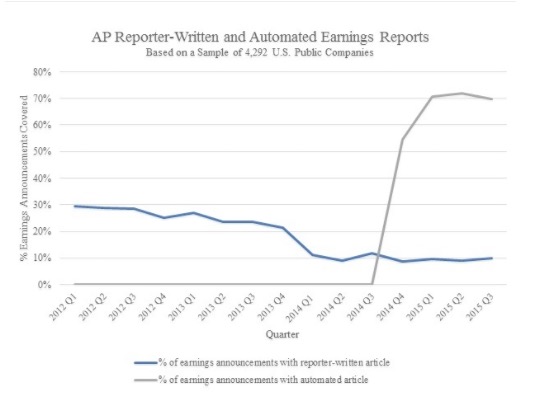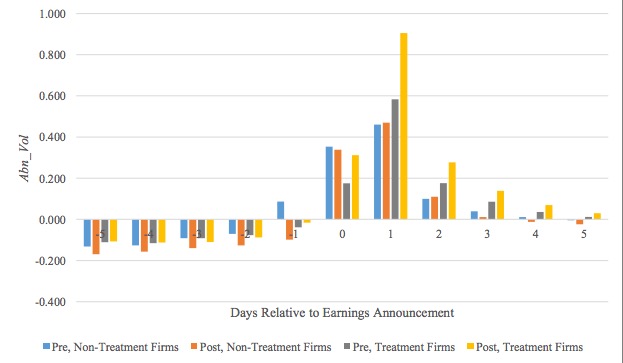The Associated Press’ automated coverage of company’s earnings releases has increased firms’ trading volume and liquidity, according to a new study that compared stock performance of companies that the AP only started covering after it began using algorithms to write earning report stories in 2014. (The AP collaborated with the study’s researchers.)
By late 2015, the AP was covering more than 4,000 earnings report stories per quarter, up from about 400 before it began using algorithmically written stories. The study’s authors — Stanford professor Elizabeth Blankespoor, University of Washington professor Ed deHaan, and Stanford PhD student Christina Zhu — found that 57 percent of those companies received no coverage from the AP before the automation started in October 2014.

Companies that were newly covered by automated reporting saw their trading volume increase by about 38 percent, the study found. However, the researchers saw that “abnormal trading volume increases nearly monotonically for several quarters after automated articles begin, suggesting that it takes time for the articles to impact investor attention and/or trading behavior.”

“After the articles are published, we see an increase in trading volume that persists three to four days after the story comes out,” deHaan told the AP.
The report also found that the companies receiving coverage had improved liquidity because “increased trading volume potentially creates a deeper market, and lower information processing costs can result in less information asymmetry, less price protection, and greater willingness to trade.”
Beyond earnings reports, the AP is also working on further automating its reporting processes. This year it began algorithmically covering minor league baseball games by converting data from box scores into traditional stories.“With minor league baseball, we never had any stories and didn’t cover it with humans,” Jim Kennedy, the AP’s senior vice president for strategy and enterprise development told me this fall. “Now we’re covering it without humans and creating stories that we didn’t have before. That’s been a real breakthrough. Based on that success, we wanted to see what else could we do in automation.”
Kennedy said the AP has a goal — that’s “more aspirational than real” — to automate 80 percent of its content production by 2020. (A spokeswoman also later acknowledged this was probably unrealistic.) The news agency wants to use machine learning to help reporters produce multiple versions of stories for different mediums or for specific clients.
“Let’s say a newspaper or website is subscription-based and, in its research, it’s identified five personas that are its typical subscribers,” Kennedy said. “If we perfect this, we could design output for those five personas and drive some or all of our output through those five personas.”